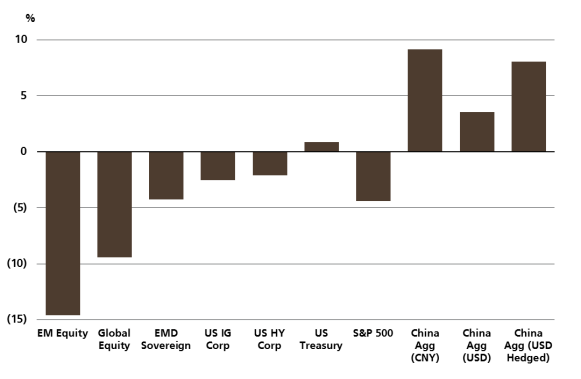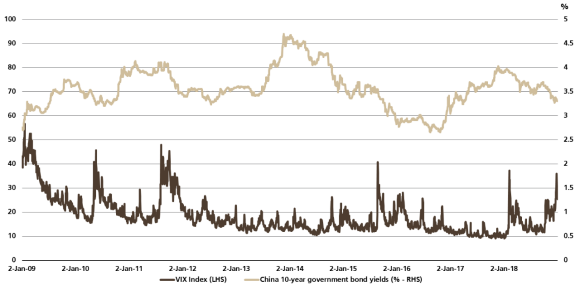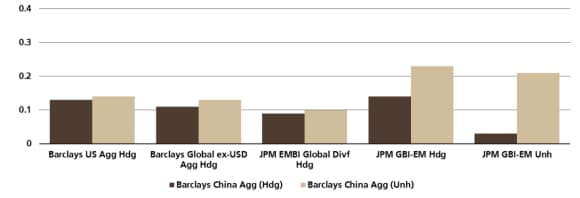The emerging safe haven asset you might not own, but probably should
China onshore bonds are emerging as a new safe haven asset and Hayden Briscoe, Head of Asia Pacific Fixed Income, explains why
- While emerging markets bonds sold off in 2018, China government bonds outperformed;
- Over a long-run time period China government bonds are showing all the traits you'd associate with safe haven assets;
- We believe their position as a flight-to-quality asset will grow as China continues to reform, the index inclusion process progresses, and the RMB takes on a larger global role as a reserve currency.
While most emerging markets (EM) bonds sold off in 2018, one part of the EM bond universe outperformed.
Returning 9.2% in 2018, the Bloomberg China Aggregate benchmark outshone the 4.4% drop in the EM sovereign debt and the 14.6% drop in EM Equity benchmarks, according to Bloomberg data.
Returns by Asset Class Benchmark (%), FY 2018
Returns by Asset Class Benchmark (%), FY 2018

We believe that's because the Bloomberg China aggregate is largely made up of China government bonds, which are emerging as an alternative safe haven asset to the more traditional safe haven assets like US Treasuries, gold, and the Swiss franc.
China government bonds are starting to behave exactly the way you would expect safe haven assets to during times of heightened volatility. During historic spikes in the widely-used Volatility Index (VIX) , yields on China government bonds tightened, indicating that investors increasingly look at the asset class as a safe haven.
China government bond yields (%-RHS) vs VIX Index (LHS), Jan 2, 2008-Dec 31, 2019
China government bond yields (%-RHS) vs VIX Index (LHS), Jan 2, 2008-Dec 31, 2019

And there's two principal reasons for this:
- China is a net creditor country: with current account surpluses and foreign exchange reserves of close to USD 3 trillion2 , China has an exceptionally strong external position. Furthermore, China's level of government debt as a % of GDP (65.1%) is far lower than the 116.9% in the US, and 235.4% in Japan3.
- China government bonds offer attractive yields and low correlation:at the time of writing, China government bonds offer a real yield pick-up of between 80-200bps4 compared with similar assets in US, Japan, German, and UK. Additionally, China government bonds have low correlation ranging between 0.03 and 0.23 against other major global aggregate benchmarks.
Correlation of onshore China bonds with major global bond benchmarks, October 2005-September 2018 (USD)
Correlation of onshore China bonds with major global bond benchmarks, October 2005-September 2018 (USD)

And we see three specific trends that will bolster the position of China government bonds as safe haven assets in the future, namely:
- Ongoing reforms and improving accessibility: we've seen tax exemptions and the introduction of block trading in the past 12 months, and we expect further moves from the Chinese government like widening the Bond Connect system to continue opening up the onshore market to international investors.
- The process of index inclusion: Bloomberg's inclusion of Chinese bonds is, we believe, the start of a process through which over index providers, like FTSE Russell and JP Morgan, bring onshore bonds into their indices, with China government bonds likely being only the first bond class to be included.
- The rise of the RMB as a reserve currency: Though the USD is a dominant reserve currency, a number of trends are playing out that will boost the RMB as an alternative. Specifically, the closer integration of Chinese onshore markets with the global financial system, the process of index inclusion, the growing role of RMB-denominated oil payments, and the rise of CHAPS as an alternative to the USD-dominated SWIFT payment system.
So with these trends in mind, plus compelling fundamentals, we believe that China government bonds may continue to emerge as a go-to, safe-haven asset, and that's something that all investors should be aware of.
